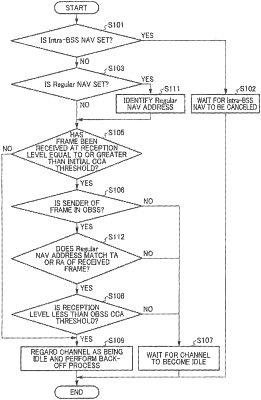| CPC H04W 74/0816 (2013.01) [H04W 16/14 (2013.01); H04W 84/12 (2013.01)] | 7 Claims |

|
1. A wireless communication device comprising:
a receiver configured to receive a first frame addressed to a first wireless communication device other than the wireless communication device;
controlling circuitry configured to
set a first transmission prohibition period for a first network in response to determining that a sender of the first frame belongs to the first network to which the wireless communication device belongs based on the first frame,
set a second transmission prohibition period for a second network in response to determining that the sender belongs to the second network, the second network being a network overlapping with the first network,
determine, when the receiver receives a second frame addressed to a second wireless communication device other than the wireless communication device during a carrier-sensing in a period during which the first transmission prohibition period is not set and the second transmission prohibition period is set, and when a reception level of the second frame is a first threshold or more, whether a sender network of the second frame is the first network or the second network based on the second frame, and
compare, in response to determining that the sender network is the second network, the reception level of the second frame with a second threshold greater than the first threshold to determine whether a state of a wireless medium is an idle state or a busy state.
|